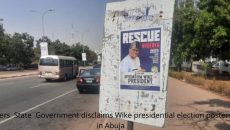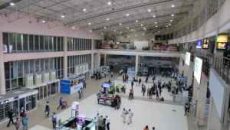From 1975 when the idea was conceived till 2014, Abuja has been an unfolding story of unity, beauty, business and power
By ANAYOCHUKWU AGBO
Abuja is an engaging story of an evolving mega polis, says Bala Mohammed, minister of the Federal Capital Territory, FCT. Every minister and every president add some chapters to the tale, raising the national symphony to higher octaves. It is like the mythical circle around which another can always be drawn in the search for perfection.
On August 9, 1975, the military government of late General Murtala Ramat Muhammed decided to give Nigeria a new befitting capital because Lagos, then Federal Capital had become congested. Lagos being both capital of a state and capital of Nigeria brought population explosion and the consequent pressure on infrastructure. Lagos lies almost below sea level and this caused frequent flooding and ocean surge. Other challenges were: limited land mass for development; traffic congestion; inadequate housing; environmental pollution; relative insecurity; obscure or peripheral location which meant that many Nigerians had to travel long distances to reach their capital. Again Lagos belongs to a particular ethnic group, which according to them, made it difficult for the city to be truly national or neutral. In addition, Lagos was under too much pressure being an entry point for international trade as well as state and federal capital.
The government set up an eight-man panel headed by Akinola Aguda, a legal luminary and one-time chief justice of the Republic of Botswana, to examine the problem of Lagos and proffer acceptable solutions. Other members of the panel were: Tai Solarin; O. K. Ogan, a professor; Monsignor Pedro Martins, a colonel; Owen Flebal, a chief; Mohammed Ismail Bashir and Ajato Gandan, a professor and E. E. Nsefik, a chief who served as the secretary. After their extensive tour of 30 possible locations across the country, the panel submitted its report in December 1975. The report declared Lagos unfit as the nation’s capital being the commercial and industrial hub of the country.
The Aguda panel, as it is popularly known, recommended a vast virgin territory in the middle of Nigeria to replace Lagos as the capital of the country. The whole of this ‘vast territory’ was named Abuja, after one of the numerous villages that were later displaced to create the new capital. The name Abuja came from the name of the founder of the village, Abubakar Ja, a prince whose father was beheaded for not taking a community he conquered into slavery. After being caged for seven years, seven months and seven days he was released. He then founded a new settlement. Abubakar Ja means Abubakar yellow; Abuja was coined from the two names – Abuja.
The modern Abuja, the Federal Capital Territory, FCT, was carved out of four states: Niger, Nasarawa, Kaduna and Kogi, and covers about 8,000 square kilometres. The factors gave Abuja the edge over the other 30 locations considered were: its central location in the middle of the country, good climate, very low population density, availability of land for future expansion, physical planning convince and ethnic harmony.
Based on the recommendation, on February 5, 1976 the military government of late General Muhammed created the new FCT via Decree No. 6. The decree vested the responsibility of the development of Abuja with the Federal Capital Development Authority, FCDA. In June 1977, FCDA engaged International Planning Associates, IPA from United States to prepare a draft master for Abuja and its environs. It took IPA a year and a half to produce a 286-page master plan.
According to the design, which provided for a phased development, Abuja was divided into sectors, districts, and neighbourhoods and each sector would have a population of between 100,000 and 250,000. Abuja was projected to have a population of 1.6 million after the completion of Phase One and 3.1 million after the completion of Phase Two. Today only Phase One is completed but the population is about 3.5 million. About 1.96 per cent of the Federal Capital City, FCC, was set aside for government use; 3.49 per cent for auxiliary services; and 48.97 per cent for residential development; 3.61 for light industries; 7.22 per cent for infrastructure; 2.2 per cent for commercial use and 32.50 per cent for green areas and recreational facilities. Kenzo Tange, a Japanese architect, planned and designed the Central Business District, filling the gaps left by the master plan.
The master plan set 1986 for the first movement of the federal government to Abuja. That year Nigeria hosted ECOWAS conference in Abuja and this quickened the pace of work. The successful hosting of the ECOWAS conference quickened the relocation of government from Lagos to Abuja. In 1987, ECOWAS relocated its secretariat to Abuja. And in 1991, the African Union summit was successfully hosted in Abuja. A few days after the conference on December 12, 1991, federal government finally relocated to Abuja. General Gado Nasko, then FCT minister handed the then military president, General Ibrahim Babangida, key to the city at the city gate. It symbolised the handover of the city to the landlord, for indeed the President is the governor of FCT. This power he entrusts to the FCT minister to exercise on his behalf.
Since 1976, Abuja has had 15 administrators as follows: Ajose Mobolaji Adeogun (1976 – 1979); John Jatau Kadiya (1979 – 1982); Abubakar Iro Danmusa, (1982 – 1983); Haliru Dantoro, (Oct. 1983 – Dec. 1983); major Gen. Mamman Jiya Vatsa, (1984 – 1985); AVM Hamza Abdullahi, (1986 – 1989); Major Gen. Mohammadu Gado Nasko, (1989 – 1993); Lt. Gen. Jeremial T. Useni, (1993 – 1998); Maj. Gen. Mamman Tsofo Kontagora (1998 –1999); Architect Ibrahim Baba Bunu (1999 – 2001); Engineer Muhammed Abba-Gana, (2001 – 2003); Mallam Nasir Ahmed el-Rufai, (2003-2007); Dr. Aliyu Modibbo Umar, (2007 – 2008); Senator Muhammad Adamu Aliero, (December 2008 – April 2010). The present minister, Senator (Dr.) Bala A. Mohammed was appointed on April 6, 2010 by President Goodluck Ebele Jonathan.
Follow Us on Social Media





 WhatsApp us
WhatsApp us